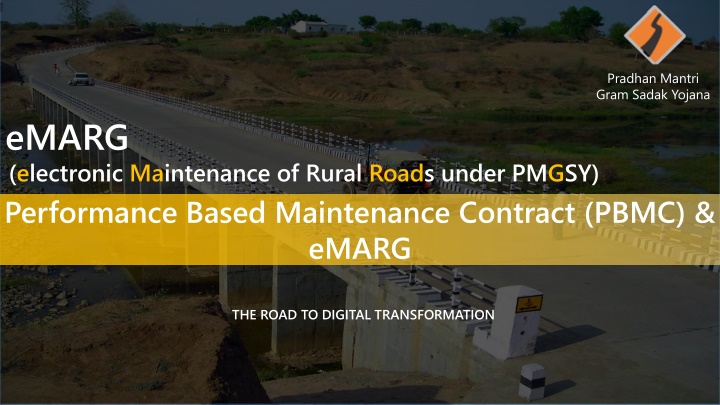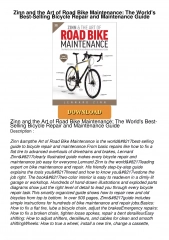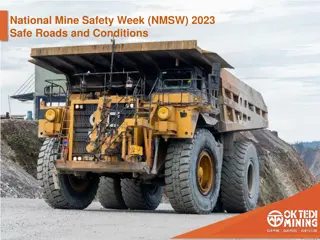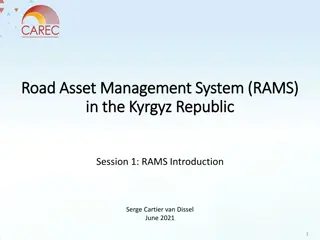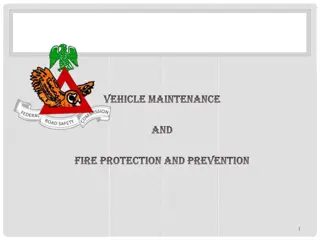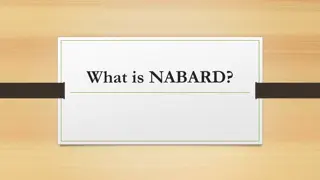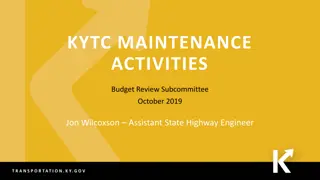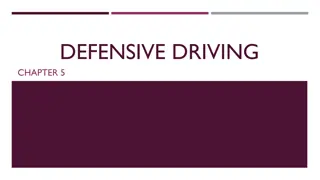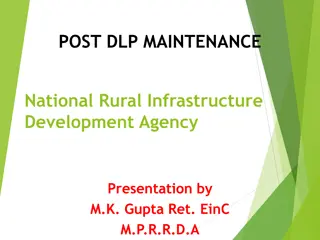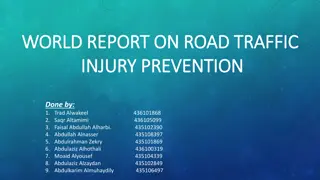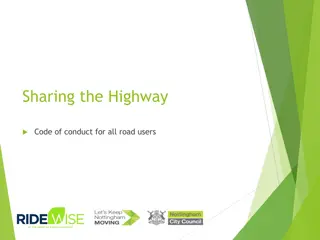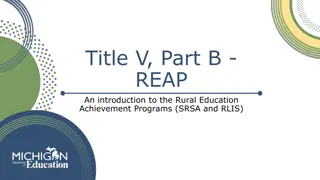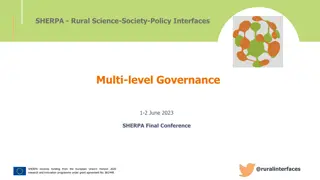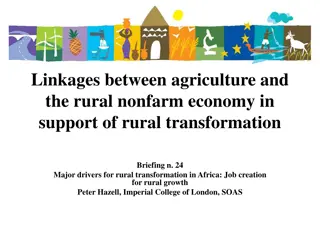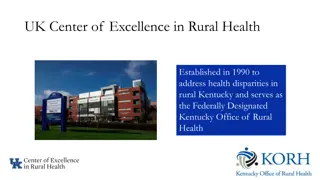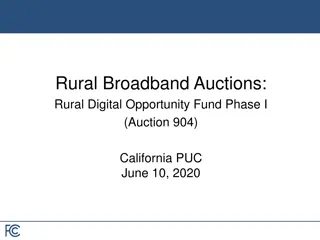Importance of Timely Maintenance in Rural Road Networks
Ensure the timely maintenance of Pradhan Mantri Gram Sadak Yojana (PMGSY) roads to avoid exponential repair costs and the need for reconstruction. Learn about different types of maintenance, minimum requirements, and the roles of contractors and engineers in the process.
Download Presentation

Please find below an Image/Link to download the presentation.
The content on the website is provided AS IS for your information and personal use only. It may not be sold, licensed, or shared on other websites without obtaining consent from the author.If you encounter any issues during the download, it is possible that the publisher has removed the file from their server.
You are allowed to download the files provided on this website for personal or commercial use, subject to the condition that they are used lawfully. All files are the property of their respective owners.
The content on the website is provided AS IS for your information and personal use only. It may not be sold, licensed, or shared on other websites without obtaining consent from the author.
E N D
Presentation Transcript
Pradhan Mantri Gram Sadak Yojana eMARG (electronic Maintenance of Rural Roads under PMGSY) Performance Based Maintenance Contract (PBMC) & eMARG THE ROAD TO DIGITAL TRANSFORMATION
Need for timely maintenance of PMGSY Roads If Roads are not maintained routinely and on time, the cost of repair increases exponentially, till the point the entire Roads need to be reconstructed, which isn t feasible at this scale Pradhan Mantri Gram Sadak Yojana Types of Maintenance of PMGSY Roads Rural Road Connectivity Periodic Renewal of Roads which have completed 5 years of construction Routine Maintenance of Roads post 5 years of completion Routine maintenance for 5-years post construction 7,68,000 km of Roads sanctioned 6,67,000 km Roads constructed DLP Maintenance 3,32,500Cr Asset value worth Post DLP Maintenance Defect Liability Period (DLP) 12% of India s entire Road network The initial period of 5 years post construction completion date of a Road in which the same contractor who has constructed the Road has to carry out the routine maintenance also No separate contract is signed for carrying out the routine maintenance for 5 years post construction 1,78,000+ habitations connected 40.5 Cr population (48% rural population) benefitted
MAINTENANCE OF ROADS BEFORE INTRODUCTION OF eMARG
Minimum Requirements of Routine Maintenance Standards: (Source: Cl 32.4 of SBD) Potholes on the Road surface to be repaired soon after these appear or brought to his notice either during the Contractor s monthly inspection or by the Engineer Road shoulders to be maintained in proper condition to make them free from excessive edge drop offs, roughness, scouring or potholes Cleaning of surface drains including reshaping to maintain free flow of water Cleaning of culverts and pits for free flow of water Maintenance of Road signs, pavement markings and other traffic control devices Any other maintenance operation required to keep the Road traffic worthy at all times during the maintenance period.
Roles and Responsibilities of Contractor and Engineers for carrying out DLP Routine Maintenance (Source: Cl 32 of SBD, Ch-14 of Operations Manual) Role of contractor Conducts Inspection of Road once every month to record any defect which needs to be corrected Rectifies the defect and Submits his record to engineer that the defect has been rectified submits the bill every month within 10th day of succeeding month Role of Engineers Routine Inspections to be carried out by Engineers to record any defect in following order: 1. JE- Every month 2. AE- Every two months 3. EE- Every six months (one before monsoon and one after) Inspections to be carried out by dividing each Road into km stretch and each km to 200m section All Defects to be recorded and notified to contractor to rectify within a specified time limit Maintenance log book to be maintained for each Road for keeping a record of status of defect if corrected or not
Sample of Maintenance Log Book (Source:Ch-14 of Operations Manual)
Payment to Contractor for DLP Routine Maintenance (Source: Cl 32 of SBD, Ch-14 of Operations Manual) Cost Estimation of Routine Maintenance (Cl 14.5.1 and Annex 14.4 of Operations Manual) Example of Calculating estimate of quantity for filling up the pot holes: Suppose the length of Road is 3km and CW width is 3.75m and the Road is in High rainfall area with Traffic of more than 45 CVPD Calculation of estimate for filling up pot holes during 1st year: Quantity required as per rainfall criteria= (1/100*3000*3.75) = 112.5 sqm Total Quantity required by accounting for traffic also = 1.5*112.5 = 168.75 sqm Let the rate of filling pot holes be 100/sqm Lump sum amount for 1st year = 168.75*100 = Rs16875
Payment to Contractor for DLP Routine Maintenance Raising of monthly bills of routine maintenance by the contractor The bills of fixed amount based on the lump sum rate quoted by contractor will be raised by contractor every month Example: Year of Maintenance Lump sum rate quoted by contractor Amount for which monthly bill to be raised by contractor I Year 1,20,000 (1,20,000/12)= 10,000 Contractor has to raise the bill of this fixed amount only irrespective of the actual value of work done by him Even though there was no defect in the Road and contractor has not done any work, then also the contractor needs to submit bill for that month II Year 2,40,000 (2,40,000/12)= 20,000 III Year 3,60,000 (3,60,000/12)= 30,000 IV Year 4,80,000 (4,80,000/12)= 40,000 V Year 6,00,000 (6,00,000/12)= 50,000 Payment to be made to the contractor Cl 34.2 of SBD: The payment for routine maintenance of Roads to the Contractor is performance based Cl 38.2 of SBD: The Contractor shall submit to the Engineer a bill every month for the routine maintenance of the Roads from the date the maintenance period starts i.e. from completion date as defined in Clause 1.1, it will be supported with a copy of the record of the Contractor s monthly inspection and other instructions received from the Engineer The payment will be made monthly for the monthly bills received and as certified by the Engineer based on performance by the Contractor If the bill for a month is not received from the Contractor by the 10th day of the succeeding month or/ and if the Engineer has not certified that the Contractor has carried out the maintenance work for defects brought to his notice under clause 32.6 within specified period, no payment will become due to the Contractor for that month If the Contractor has failed to carry out the maintenance within the period specified by the Engineer, no payment of any kind will be due to the Contractor for that month
Practice to be followed for carrying out DLP routine maintenance (Source: Cl 32 of SBD, Ch-14 of Operations Manual) Each Road is divided into km stretch and each km to 200m section Routine Inspections to be carried out by Engineers to record any defect in following order: 1. JE- Every month 2. AE- Every two months 3. EE- Every six months (one before monsoon and one after) Contractor Conducts Inspection of Road once every month to record any defect which needs to be corrected All Defects to be recorded and notified to contractor to rectify within a specified time limit Contractor rectifies the defect and Submits his record to engineer that the defect has been rectified Are defects found on Road Yes Maintenance log book to be maintained for each Road for keeping a record of status of defect if corrected or not No Bill for the month will not be paid to the contractor Engineer to verify if defects are corrected No Contractor submits the bill of fixed amount every month within 10th day of succeeding month Yes Bill for the month will be paid to the contractor
Issues in the system prior to eMARG for carrying out DLP routine maintenance Even though it was mentioned in the SBD that the payment to contractor will be performance based still 15 states followed the Bill of Quantity(BOQ) based system for payment to contractor for routine maintenance works also: PIU inspects the Road to verify the bill is genuine Payment is done to the contractor Contractor measures the size of patch to be filled Contractor submits the bill based on size of patch filled PIU receives the bill Not allowed This BOQ system of payment was not allowed for PMGSY Roads for routine maintenance but due to lack of a unified system, it was still followed in some of the states Even though it was mentioned in the SBD that the payment to contractor will be performance based, but the performance is not defined clearly as to how the performance will be measured for making payments. There was a lack of well defined uniform performance matrix based on which the payment was to be made to the contractor The whole process is manual in nature and too many physical records have to be maintained Lack of transparency in the system. If the higher authority wanted to know the status of maintenance of any Road, then they had to rely on the physical record if maintained by the engineer No system to monitor the maintenance of Roads by SRRDA/NRIDA. The only way to figure out was by monitoring the expenditure done against a particular Road and booked in OMMAS
How to develop a single and robust management and monitoring system which ensures that Maintenance work for such a huge Road infrastructure is being carried out in to the required standard in an effective and transparent manner? eMARG Web based IT solution for all issues in carrying out and managing huge network of maintenance of Roads eMARG implements the Performance Based Maintenance Contract (PBMC)
eMARG and Performance Based Maintenance Contract (PBMC)
PERFORMANCE BASED MAINTENANCE CONTRACTS (PBMC) A type of contract in which payment to the contractor is made based on the minimum condition of Road, CD works and traffic assets that have to be maintained by him/her Payments are based on how well the contractor manages to comply with the performance standards or service levels defined in the contract, and not on the quantity of material that he has used in maintaining the Road Measure if the Road finally is in good condition or not and is unrelated to how much effort contractor has put in to bring Road in a good condition The Road is given marks out of 100 on various parameters and finally the amount to be paid to the contractor depends proportionately on the marks obtained by the Road Advantages: Measuring outcomes is easier than measuring inputs Contractor incentivized to construct better Road such that less inputs in maintaining Road but still gets good outcomes Evidence based assessment of Roads S.No Parameters Marks S.No Parameters Marks Maintenance of Road signs, speed breakers, standing trees adjacent to Road wherever required Maintenance of 200 m and Kilo Meter stones Cutting of branches of trees, shrubs and trimming of grass and weeds etc White washing parapets of Works including CD Painting of guard stones Re-fixing displaced guard stones Maintenance of surface of Road including filling potholes and patch repairs etc. 1 50 7 2 Score (?/100) Payment PERFORMANCE MATRIX FOR MAINTENANCE OF Road 2 Making up of berms/shoulders 20 8 2 < 80 NIL Restoration of rain cuts and dressing of side slopes/berms 3 10 9 3 Between 80 -100 (say 85) 85% of maintenance amount 4 Maintenance of drains 3 10 2 5 Maintenance of culverts and cause ways 4 11 12 2 1 Maintenance of guard rails and parapet rails 6 1 Total 100
BASIC PROCESS FLOW FOR DESIGNING eMARG SOFTWARE Start Online Generation of eBills by software Registration of Contractor Submission of eBills by contractor on click of a button Digital Payment to contractor in his account Start Outcomes Based Performance Evaluation of Road for giving marks out of 100 based on Inspections conducted Inspections done by engineers through Mobile App by uploading photos Processing of Bills based on Marks obtained in Performance Evaluation Digitization of entire process eBill Generation and Submission as the bill amount is fixed for every month App based Routine Inspections to keep a record of inspections carried out System generated vouchers based on score leading to less to-fro between account officers and District Engineers on amount Evidence of Maintenance carried out for the Road is kept in the system for anytime access
Data Requirement for development of eMARG
DATA REQUIRED FOR DEVELOPMENT OF eMARG Sanctioning of works by MoRD: State/SRRDA selects and gets approval for individual Roads which will be constructed/ upgraded in a district Awarding of works: Bidding for construction/ upgradation is done for a Package and not for individual Roads The complete package (by default every Road of package) is awarded/tendered to a single contractor Based on the ground condition/value of work, more than one Roads can be clubbed together to form a single Package Every Road is assigned a package No. (A package can have one or more than one Roads) The Agreement No., agreement start date and project completion date will be applicable for the complete package Unless the construction/ upgradation of all the Roads of the package is complete, the DLP of the Road will not start The complete package and not the individual Road will undergo DLP routine maintenance The data is required at Package level for development Example: Suppose for a district XYZ of ABC state, 10 Roads are sanctioned Details of Tenders of Road Sanctioned Roads Road#1, Road#2, Road#3, Road#4, Road#5, Road#6, Road#7, Road#8, Road#9, Road#10 Package# Roads Contractor Agreement No. Agreement Date Project Completion Date as per contract Package 1 R1,R2, R3, R4, R5 Contractor-A XYZ/12345 1/1/2020 1/12/2020 Packaging of Roads Package 1: Road#1, Road#2, Road#3, Road#4, Road#5 Package 2: Road#6, Road#7 Package 3: Road#8 Package 4: Road#9, Road#10 Package 2 R6, R7 Contractor-B XYZ/67891 1/2/2020 1/1/2021 Package 3 R8 Contractor-C XYZ/24782 10/1/2020 10/12/2020 Package 4 R9, R10 Contractor-D XYZ/76543 20/1/2020 20/12/2020
DATA REQUIRED FOR DEVELOPMENT OF eMARG District-1 DPIU-1 Package-1 Package-3 Package-2 Administrative Hierarchy of PMGSY Works STATE District-2 DPIU-2 Package-5 Package-4 District-3 Package-6 DPIU-3 District Project Implementation Unit (DPIU): If a district is large in size or large no. of works are sanctioned in a district is , then to have a better administrative control, a district is further divided into divisions and then DPIU is formed by joining these divisions A district can have one DPIU or more than one DPIU The unit which is responsible for construction and maintenance of Roads assigned to them. It generally has three level of Engineers, i.e. JE/AE/EE Every package is associated with a single unique DPIU on ground *DPIU is more commonly called as PIU. So DPIU and PIU mean the same Additionally the lump sum maintenance rates are dependent on CW width and Traffic Density also Summary of Data/Information Required for a package for its routine maintenance State District Block DPIU Package No. Road Name Traffic Category CW Width Completed Length Completion Date Agreement No. Agreement Date Contractor Name PAN No. of contractor
SOURCE OF DATA AND ITS EXCHANGE All data of a road, from sanction to award/tender till completion is entered by PIU in OMMAS. Thus OMMAS is the source of parent data and the relevant data for development of eMARG needs to be sent from OMMAS to eMARG To start the development process in eMARG, first time data was exchanged manually in excel sheet on 11th July 2019 and 4th Dec 2019: Master list of Names of States, Districts, Blocks, DPIUs and Departments maintained in OMMAS sent to eMARG List of Packages completed between 1/10/2013 to 31/10/2019 in the required format sent to eMARG eMARG puts the following validations on the package data received from OMMAS: 1. Maintenance Agreement No. is present 2. One package should have one maintenance agreement No. 3. Traffic category Data should be present 4. CW width data should be present 5. Completed Length and completion date of road should not be zero 6. Contractor s PAN No. should be present and should be in correct format The following Data was shown to concerned PIUs in eMARG and was asked to confirm if it was correct: Completed length, Completion Date, Agreement No., Agreement Date, Contractor Name, Contractor PAN, CW width, Traffic Density Yes Is the data valid The package was accepted by eMARG The Data was used for development of eMARG No The package was rejected by eMARG The Package was allowed to proceed further in eMARG Yes No Is the data Correct Need to correct data in OMMAS
